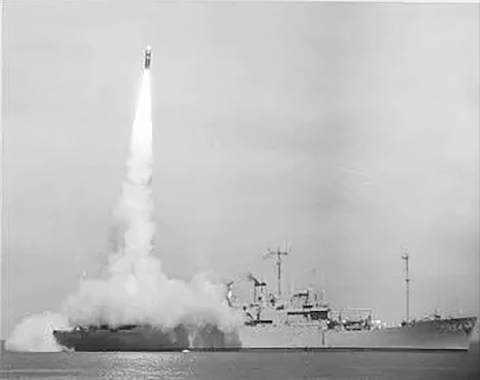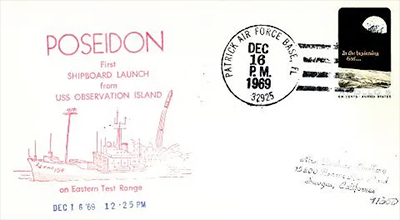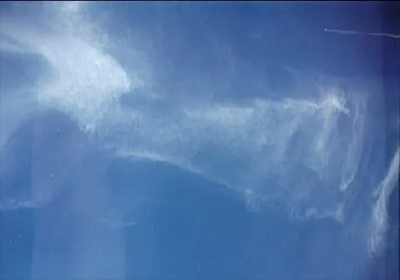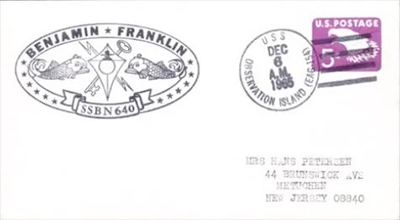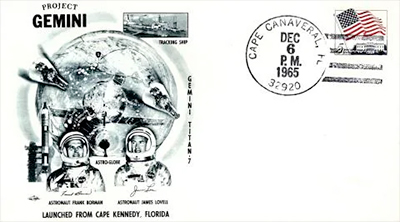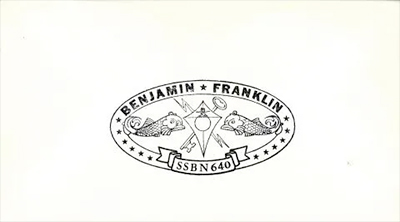Space Cover #135: USS Observation IslandMilitary launches played a huge role in early rocket development. Missiles from submerged vehicles and/or launch pads would be no exception. The USS Observation Island would play a role in this development from 1959 to its decommission in 1972. The crew of the USS Observation Island was 65 civilian and 20 US Navy personnel.
In June 1959 the USS Observation Island, after being fitted with additional equipment, including the Ships Inertial Navigation System (SINS), steamed for her new homeport, Port Canaveral, Florida., and made preparations for the first at-sea launch of a Polaris missile. Designated UGM-27, the missile was successfully launched from the USS Observation Island on August 27.
Following this milestone, the USS Observation Island steamed to the Norfolk Naval Shipyard for installation of a fire control system to enable her to launch more sophisticated guided versions of new generation Polaris missiles. She also received a new launcher, the developmental prototype of those installed in the Fleet Ballistic Missile (FBM) submarines.
This work was completed in January 1960 and the USS Observation Island returned to Port Canaveral to continue Polaris test launch operations. After a total of six launchings, the ship commenced support of Polaris launchings from FBM submarines. She provided optical and electronic data gathering services, and acted as communications relay station between submerged submarines and the supervisor of range operations at the Cape. The first successful fully guided Polaris missile launching from a submerged submarine took place July 20, 1960 from the USS George Washington (SSBN-598). Through October the USS Observation Island also supported launches from the USS Patrick Henry (SSBN-599).
Following further modifications at Norfolk Naval Shipyard in the fall of 1960, Observation Island returned to Port Canaveral in December to continue FBM support work and systems test and evaluation. She received the Navy Unit Commendation December 15, 1960; launched the new A-2 Polaris March 1, 1961; and supported the first submerged A-2 launch from the USS Ethan Allen (SSBN-608) on October 23, 1961.
In late 1961 the USS Observation Island served as a survey ship on the Atlantic Missile Range, and in January 1962 she again put in at Norfolk Naval Shipyard, this time for modifications preparatory to launching the new A 3 Polaris. Returning to Port Canaveral in March, she supported FBM submarines through the following autumn, when she steamed for two months of operations on the Pacific Missile Range.
The USS Observation Island was back at Port Canaveral by Christmas, and until June 1963 she expanded her role of oceanographic survey in the Atlantic Range. She conducted the first successful at-sea launches of the A-3 Polaris on June 17 and 21st. President John F. Kennedy came on board November 16, 1963 to observe a Polaris launch.
She then continued to operate essentially as a sea-going platform from which missile launches can closely approximate conditions encountered in FBM submarine launches. Her equipment was constantly being modified, allowing prototypes to be tested thoroughly before missiles and associated components become operational with the US Navy Fleet. As a mobile platform, she conducted tests on instrumented ranges.
The USS Observation Island was redesignated AG-154 on April 1, 1968. She commenced an extensive ten month conversion June 24, 1968 at Norfolk Naval Shipyard in preparation for support of the Poseidon C-3 missile program. The summer of 1969 found her once again at Port Canaveral, ready to resume experimental missile launchings, to assist in the training of FBM submarine crews, to assist in FBM submarine shakedown operations at Cape Kennedy, and to support other important phases of the development and deployment of FBM Weapons System. She continues this significant work until decommissioning on January 1, 1972.
Covers from the USS Observation Island are collected by both space and naval collectors but are very reasonably priced. Shown below is a cover sent to the “Prospective Commanding Officer of the USS Observation Island with an invitation to the commissioning ceremony.
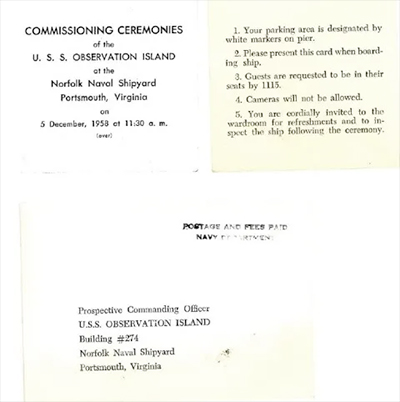
Interestingly, the cover below was cancelled for the commissioning and then turned into a “possible” space cover by the addition of the data of the flight of a Terrier 1 rocket from Wallops Island that day. In all actuality this is only a commissioning cover. The USS Observation Island did create two different RSC to be applied to covers sent in by collectors with covers mailed for both launches from the ship itself and while observing launches from the FBM submarines. The one depicted was created for the Polaris program, a later cachet was a more generic cachet to the ship. Covers with USS Observation Island cancels are also found with Goldcraft cachets and many of the covers in the mid-1960s have naval servicer cachets.
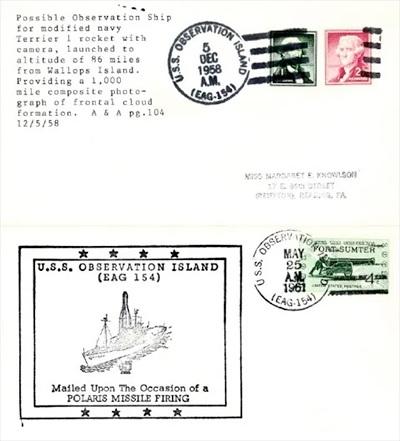
Thanks to hullnumber.com for detailing the history of the USS Observation Island used in this post.











